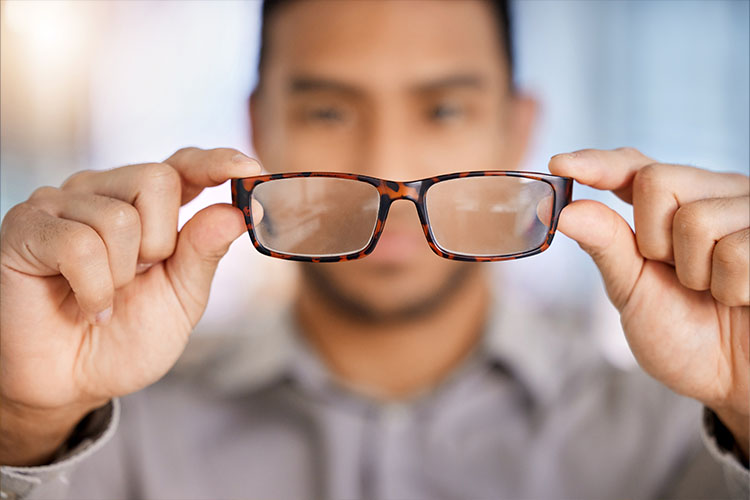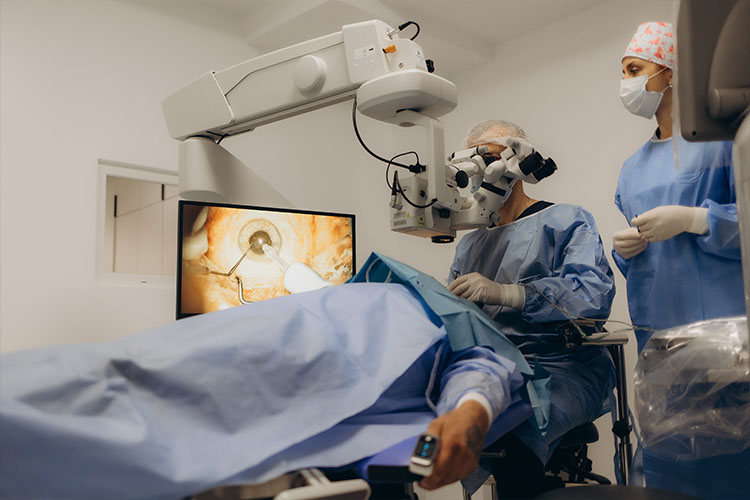Overview
Hyperopia, or farsightedness, is a common refractive error where nearby objects appear blurred, while distant objects may remain in focus. This condition occurs when light entering the eye is focused behind the retina instead of directly on it, usually due to the eye being shorter than average or having a cornea with insufficient curvature. People with hyperopia may experience difficulty with tasks that require close-up vision, such as reading or working on a computer, and symptoms can include eye strain, headaches, and squinting. The degree of hyperopia varies from mild cases, which may not require treatment, to more severe cases that significantly impact daily activities.
There are several treatments available for hyperopia, each designed to correct the eye’s focusing ability and enable clear vision at close range. The most common approaches include corrective lenses, such as eyeglasses or contact lenses, which help redirect light onto the retina. For those looking for a more permanent solution, surgical options like LASIK, PRK, and refractive lens exchange can reshape the cornea or replace the eye’s natural lens to correct the refractive error. These surgical methods vary in effectiveness, cost, and recovery time, and not everyone is an ideal candidate, as factors like age, eye health, and degree of hyperopia can affect suitability.
The choice of treatment for hyperopia ultimately depends on several factors, including the patient’s age, lifestyle, and personal preferences. For children and young adults, corrective lenses may be sufficient and less invasive, while adults seeking a long-term solution might consider surgical options after consulting with an eye care specialist. Regular eye exams are crucial for detecting hyperopia early and discussing the best corrective measures with a healthcare provider to ensure optimal visual health.
Table of Contents
When to See a Doctor
For individuals with hyperopia, it’s important to know when to seek medical advice to manage symptoms and prevent potential complications. Many people with mild hyperopia may not notice symptoms initially, especially if the eyes are able to compensate for the refractive error. However, as hyperopia progresses or if symptoms interfere with daily life, consulting an eye care professional is recommended to evaluate vision and explore corrective options.

You should consider seeing a doctor if you experience persistent symptoms such as blurred vision, frequent headaches, eye strain, or difficulty focusing on close objects. These symptoms can be disruptive and may worsen over time without proper treatment. Additionally, children who show signs of vision problems, such as squinting, holding objects very close, or complaining of vision-related discomfort, should also be evaluated, as early diagnosis and treatment are essential for healthy visual development.
Regular eye exams are crucial, especially if hyperopia is already diagnosed, as they allow for timely adjustments in corrective lenses or evaluation for other treatment options. Comprehensive exams can also help detect other eye issues that may be associated with hyperopia, such as strabismus (crossed eyes) or amblyopia (lazy eye) in children. By seeking professional care at the right time, individuals can manage hyperopia effectively and protect their long-term vision health.
What Type of Doctor to Seek
For hyperopia, it is best to consult an optometrist or an ophthalmologist. An optometrist can diagnose and treat hyperopia with corrective lenses or refer you for further evaluation if needed. They perform comprehensive eye exams, provide prescriptions for eyeglasses or contact lenses, and monitor changes in vision over time. An ophthalmologist, who is a medical doctor specializing in eye health, can offer a wider range of treatments, including medical and surgical interventions. If you’re considering surgical options to correct hyperopia, an ophthalmologist is the appropriate specialist to consult.
In cases of pediatric hyperopia, it’s especially important to see an eye doctor experienced in children’s eye health. Pediatric optometrists or ophthalmologists have the specific skills to assess and manage vision problems in children, ensuring they receive the correct prescription and treatment to support their visual development.
What to Expect From Your First Doctor Visit
During your first visit for hyperopia, the doctor will conduct a comprehensive eye examination to assess the degree of farsightedness and determine the best course of treatment. This exam typically involves several steps:
- Medical and Vision History Review. The doctor will ask questions about your overall health, family history of eye conditions, and any symptoms you’re experiencing, such as difficulty with near vision, headaches, or eye strain.
- Visual Acuity Test. This test measures the sharpness of your vision at various distances, typically using an eye chart. It helps the doctor gauge how well you can see at close range and identify any refractive error.
- Refraction Test. In this test, you’ll look through a machine called a phoropter while the doctor switches lenses to determine which prescription provides the clearest vision. This is a key step in developing the correct lens prescription if glasses or contacts are needed.
- Eye Health Examination. The doctor will check the overall health of your eyes, including the cornea, retina, and optic nerve. In some cases, they may dilate your pupils for a more detailed examination.
Based on these tests, the doctor will recommend a treatment plan tailored to your needs, whether that involves prescription eyeglasses, contact lenses, or a discussion of possible surgical options. For surgical candidates, additional tests may be conducted to assess the thickness and health of the cornea.
Hyperopia Treatment Options
Hyperopia, or farsightedness, can be managed effectively through the use of eyeglasses, contact lenses, or even surgical procedures for long-term correction. These treatments aim to help the eye focus light correctly onto the retina, allowing for clear vision, especially at close range. To understand these options better, here is a breakdown of each treatment:
- Eyeglasses or Contact Lenses. Wearing eyeglasses or contact lenses is the simplest approach to managing hyperopia. Although these lenses do not correct the shape of the eyeball itself, they effectively refocus light entering the eyes to improve vision. Simple reading glasses may not be sufficient for individuals with hyperopia; instead, they require prescription glasses or contact lenses specifically tailored to their condition. Before providing a prescription, an eye doctor conducts a thorough examination to determine the most suitable lenses based on the patient’s unique vision needs.

Due to the curvature of the cornea or the flatness of the eyeball in hyperopic individuals, convex lenses are typically recommended. A convex lens has a slightly curved shape that compensates for the eye’s flatter shape, allowing the patient to see clearly at close distances. Once a person starts using their prescription glasses or contact lenses, they usually notice an immediate improvement in their ability to see nearby objects.
- Various Types of Eye Surgery. For those who find eyeglasses or contact lenses uncomfortable or inconvenient, several surgical options can correct hyperopia by reshaping the cornea to improve vision permanently. The most common procedures include:
- Laser-Assisted In Situ Keratomileusis (LASIK). This is the most widely performed laser eye surgery. In LASIK, the surgeon creates a small flap on the cornea’s surface to access the inner layers. A laser then reshapes these inner layers, allowing the cornea to focus light properly on the retina. After reshaping, the flap is placed back in its original position. This procedure is suitable only if the patient’s cornea is healthy and thick enough, as LASIK requires adequate corneal tissue for reshaping.
- Laser-Assisted Subepithelial Keratectomy (LASEK). In LASEK, the surgeon creates a thin flap on the epithelium (the outer layer of the cornea) and then uses a laser to reshape the cornea’s outer layers. Unlike LASIK, LASEK involves only the surface layers, allowing for a quicker recovery. This procedure can be ideal for individuals who may not be eligible for LASIK due to thinner corneas.
- Photorefractive Keratectomy (PRK). Similar to LASEK, PRK involves reshaping the outer layers of the cornea using a laser. However, in PRK, the cornea is left to heal naturally without the replacement of the epithelial flap. PRK may require a longer recovery period but can be effective for those who cannot undergo LASIK or LASEK.
While patients have the freedom to choose their preferred corrective treatment, it’s best to consult an eye doctor for a recommendation tailored to the individual’s specific needs and condition.
Hyperopia Prognosis
The prognosis for individuals with hyperopia is generally favorable, especially with early detection and appropriate management. Mild to moderate hyperopia can often be effectively managed with corrective lenses, such as eyeglasses or contact lenses, allowing people to maintain clear vision and reduce symptoms like eye strain or headaches. For many, especially younger patients, the eyes may naturally compensate for some degree of hyperopia, and corrective lenses might only be needed for close-up tasks.
In cases of higher degrees of hyperopia or in individuals who prefer a long-term solution, surgical treatments like LASIK, PRK, or refractive lens exchange can provide lasting results. These procedures have high success rates and are generally safe, although their effectiveness depends on individual factors like age, overall eye health, and the extent of the refractive error. With advances in technology, outcomes for these procedures continue to improve, offering many patients a reliable solution for reducing or eliminating dependence on corrective lenses.
Overall, hyperopia is a manageable condition with a positive outlook for most individuals, especially with regular follow-ups to adjust treatment as needed. Children diagnosed with hyperopia may experience some improvement as they grow, but ongoing monitoring is essential to ensure they are receiving adequate vision support. Through routine eye care and the appropriate corrective approach, individuals with hyperopia can maintain good vision and quality of life well into adulthood.


